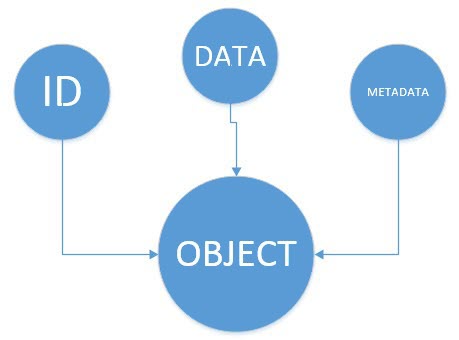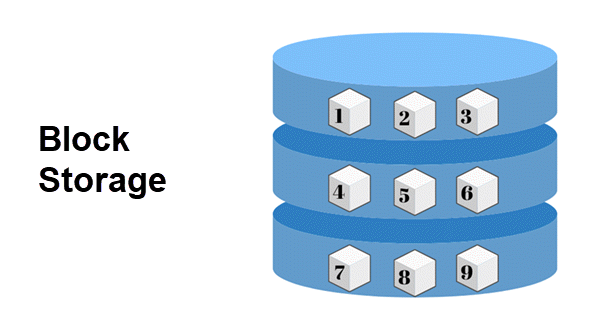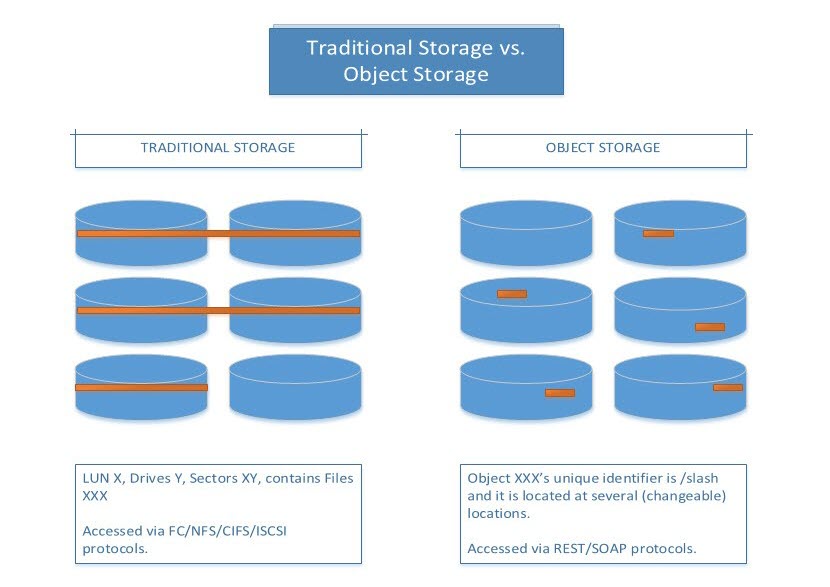It is crucial to set up your business in the best possible way. This decision is primarily determined by the workload that you anticipate.
Read on to learn more about how they differ and when to use one over the other.
Read on to learn more about how they differ and when to use one over the other.
Object Storage vs. Block Storage: Overview of the Difference
| Before examining each storage option individually, let’s take a look at some of the main differences between object storage and block storage. | Point of Comparison | Object storage |
|---|---|---|
| Block storage | Data storage | Unique, identifiable, and distinct units called objects store data in a flat-file system. Fixed-sized blocks are used to store data in hierarchical systems and can be reassembled when necessary. |
| Metadata | Unlimited, customizable contextual information. | Limited, basic information. |
| Cost | More cost-effective. | More expensive. |
| Scalability | Unlimited scalability. | Limited scalability. |
| Performance | Suitable for high volumes of unstructured data. Best performance with large files. | Best for database and transactional data storage. Performs best with files small in size. |
| Location | A centralized or geographically dispersed system that stores data on-premise, private, hybrid, or public cloud. | A centralized system that stores data on-premise or in private cloud. If the storage and application are located far apart, latency can be an issue. Data blocks are used to store data in block storage. Data blocks are stored on multiple drives in a hierarchy and can be accessed using performance protocols. |
Object storage, on the other hand, stores files in flat-file format as modular units within a single repository. Each object is a separate, self-contained unit that can be stored in multiple (changeable) locations.
Metadata
The crucial difference between object storage and block storage is the amount of metadata the data units hold. Object storage also includes contextual information in addition to basic information like owner, size and creation date. As metadata is customizable and unlimited, the data is easily organized and managed to contribute to effective data analytics.
Cost
When it comes to cost, block storage is the more expensive storage solution. Blocks are fixed size and purchasing more storage to scale up will incur additional costs. For this reason, many organizations with high volumes of data opt for object storage.
Scalability
As the number of files and users grows, block storage gains complexity and it takes more effort to find a particular file. This can eventually cause performance to suffer as the system hits its file limit. Block storage makes it more difficult to plan long-term capacity. An organization might end up overpaying for idle resources or need further capacities sooner than anticipated.
On the other hand, thanks to its flat structure, object storage allows scaling out simply by adding new nodes to the structure.
Performance
Block storage provides better storage performance than its counterpart. It is due to its storage units. Block storage is able to modify (or retrieve) only a part of a unit instead of the whole file because data is divided into successive data blocks.
Object storage, on the other hand requires that the entire file be rewritten as the data is not divided. Hence, block storage is mainly used for transactional data and databases, while object storage performs best when dealing with high volumes of unstructured data.
Note:
Object storage is unsuitable for data sets where files are modified frequently. In such cases, there is no guarantee that a retrieve request returns the most recent version of the data.
LocationObject storage is a single system that spreads across several locations. Each object has a unique identifier, and it is not necessary to know where the data is located to access them. Administration of data is conducted over an HTTP/S interface.
Block storage has a centralized system in which it stores data on-premises or in a private cloud. Knowing where a file is located is necessary to access it.
What is Object Storage?
Object storage is a storage method in which data is organized, managed, and manipulated as unique, identifiable, and distinct units called objects. The object-based storage system is different from the traditional file system. It uses a flat-file format to store data instead of the hierarchical system. All objects are kept as self-contained units in a single-level repository called a
bucket
.
Each object consists of the data it stores, comprehensible metadata, and a unique identifier. The metadata gives contextual information on each object while the identifier allows it to be located within a distributed network. This storage method is scalable to an infinite extent by adding nodes to the cluster. It is used primarily for:Storing large data. Due to its metadata, scalability and robust API, object storage is ideal for machine learning. Object storage excels in storing and accessing unstructured information.
Creating back-up copies and archives.

The object storage interface is an excellent option for data sets which are not updated frequently. Users who are not leveraging a supported backup utility (Veeam, R1Soft) can leverage the S3 interface for their backups.
Media and entertainment data storage.
This storage solution excels at storing high volumes of images, graphics, video, or audio files. It makes it possible for users to access them anywhere in the globe at lightning speeds.
- Data Storage with Ransomware Protection. Object Storage creates a copy of each file modified, allowing for data restoration in the event of a ransomware infection.
- Storing medical files. Object storage protects medical data thanks to its security features and resilient replication. Some object storage solutions come with HIPAA compliance by default. This is a crucial factor for storing medical files. Hosting a Static Website
- . Object storage can be used to host a static site that automatically scales up or down depending on the traffic. Using object storageNote:
- A static website presents the same content to all visitors. There is no content-personalization based on cookies. A static website does not use server-side scripting.What is Block Storage?
- Block storage is a form of data storage that splits data into fixed-sized units called blocks. Each block contains a small portion of data, and is identified by a unique number that can be used to reassemble the data when necessary. These unique addresses can also store blocks separately across multiple machines.Data blocks are allocated and managed using software, separated from the storage device. You send a block request to retrieve a file using a performance protocol such as iSCSI, FCoE, or FCoE. After the addresses have been found, blocks are organized into a file. Traditional storage does not store any additional data about the data, other than basic information (size, owner and creation date). Therefore, block storage needs more time to locate the required data in metadata-critical operations, which inevitably affects the overall performance.
- Still, block storage generally has low latency and is great for apps that require a high number of input/output operations. The performance and speed of block storage is superior to that of other solutions. The location of the data can affect performance. The system will retrieve files more quickly or slower if the data and application are stored closer together or further apart. Block Storage Use Cases
Block storage is primarily used for:Database storage.
Block-storage use cases
Block-storage is used primarily for:
Database Storage.

Object storage offers consistent I/O, low latency and redundancy as well as fault tolerance. This makes it ideal for resource intensive databases applications.
Storing the data of applications that need server-side processing.
These applications (such as Java PHP and.Net), require block storage.
RAID volume.
- This storage solution is used to store data on multiple disks, organized by stripping out or mirroring. Therefore, you can employ block storage as RAID volumes.Container storage.
- Block storage help with managing data stored in Docker or Kubernetes container by separating the data from the lifecycle of the container or pod and providing fixed-sized persistent storage.Storing mission-critical applications.
- Block storage is a common choice for applications that deal with mission-critical data. The low latency and excellent performance of block storage ensures that the app will function as needed. Decide between Object Storage and block storageBoth solutions have great features that are beneficial in different situations.
- Object Storage is the best solution for large volumes of unstructured information, especially when performance, durability, scalability and metadata management are important factors. Block Storage provides high performance and low latency in a variety of use cases. Its features can be used for structured database storage and VM file systems, as well as high read and write volumes.
